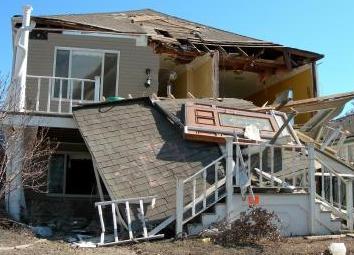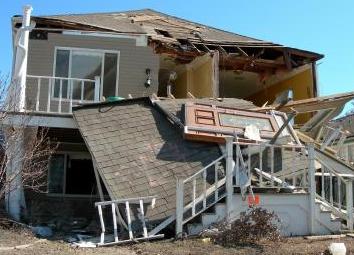 For survivors of Hurricane Isaac, the first step to recovering after the storm should be to contact their insurance company or agent and report it, according to the Insurance Information Institute.
For survivors of Hurricane Isaac, the first step to recovering after the storm should be to contact their insurance company or agent and report it, according to the Insurance Information Institute.
Consumers will want to find out whether the damage is covered under the terms of their insurance policy and, if so, how long it will take to process a claim. Then they can prepare for the claims adjuster’s visit.
An adjuster is an insurance professional trained and licensed by the state to assess damage. The adjuster can be a staff adjuster who works exclusively for the insurance company or an independent adjuster working for the company on a temporary basis, and possibly others as well.
Typically, when there is a high volume of claims from a natural disaster, insurance companies activate agreements with established independent adjusting companies in order to promptly serve their policyholders.
After filing a claim, the insurance company will either send a Proof of Loss form or schedule an appointment to have the damage inspected. In either case, in general, the more information a homeowner has about the damage the faster a claim will be settled.
Keep in mind that insurance companies do not necessarily handle claims in the order in which they are received. If someone phoned in a claim while the winds were still blowing, that does not put them at the head of the line.
Claims visits are arranged by the severity of the damage, so it is important to provide the insurer with an accurate description of the property damage. Policyholders who have been most severely impacted or have immediate financial or safety concerns will be a priority for the insurance company as well as those with a family member with special needs.
To help organize the recovery, homeowners should prepare an inventory of all damaged or destroyed items to give to the adjuster. Additionally, keep all receipts, including what was spent to make temporary repairs to protect property from further damage and any additional expenses incurred while living away from the home.
Those receipts are part of the total claims settlement, and they can be submitted for reimbursement. Keep copies of everything, including all paperwork from the insurance company. Record the names and phone numbers of everyone involved – a step that is important if the insurer sends more than one adjuster to view a property.
Many claims adjusters have special disaster recovery expertise and it is common for insurance companies to deploy these individual experts for complex claims, such as those involving considerable structural damage due to wind, damage due to flooding and the destruction of a majority of personal property within the home. If a car was damaged by the storm, an adjuster with an expertise in auto insurance may also be sent to the home.
In these cases, more than one adjuster may schedule a visit to inspect the property. The benefit of this approach is to give policyholders the most accurate and complete damage assessment. There is no charge to policyholders for claims experts who assess damage on behalf of an insurer.
Some people choose to hire public adjusters to handle their claim. Public adjusters work for the claimant and are paid a percentage of the total value of the claim amount. This can reduce the amount of money received for repairs, however. Many people choose to engage the services of a public adjuster when they have limited time to manage their own claim.
Many people with flood insurance from the National Flood Insurance Program are likely to see at least two adjusters: one adjuster representing their homeowners insurance company, who will process wind-related damage, and another representing the NFIP, who will handle damage from flooding.
If a homeowner disagrees with the settlement amount of a claim, their policy allows for an independent appraisal of the loss. In this case, both sides hire independent appraisers who choose a mediator. The homeowner and the insurance company each pay for their appraiser and share the other costs. The decision of any two of these three people is binding. However, disputes rarely get to this stage.
Here is a step-by-step guide to help prepare for the claims process:
• Make sure the insurance company has contact information such as cellphone numbers and back-up contacts, if they are available. If at all possible, try to meet the claims adjuster at the property, providing it is safe to do so.
• Complete a proof of loss form in advance and bring home inventory documents. The more information about damaged possessions the faster a claim will be settled. If a home inventory was made in advance of the storm, this will be a valuable tool.
• It’s important to make a list of all damaged items to give the claims adjuster. This will include make and model numbers of possessions, purchase dates and the price paid. Most insurers have home inventory forms to complete this step. Also make a list of any damage to show the adjuster.
• Photograph debris or destroyed items and ask the insurer if debris can be removed. Damaged items should generally not be thrown away until the claims adjuster has visited. It is also a good idea to photograph or take video of the property damage. Many insurers have the ability to accept this photographic documentation online.
• Know that the first claims check is often an advance, not a final settlement. There may be a settlement check offered from the adjuster on the initial visit. If so, it can be accepted immediately and, if other damage is discovered within the timeframe stated in the insurance policy, the claim can be reopened. Most states allow at least one year from the date of the disaster to file or reopen a claim, and some states allow more time.
• Property owners may receive three separate checks from their insurer: one for damage to the structure, one for losses related to personal belongings and a third check for additional living expenses that incurred while the home was being repaired.
• The time it takes to complete the claims process depends on the extent of the damage and the availability of contractors and resources to repair the home. Once claim is reported, its status can be checked with the insurer by phone or online.
For an in-depth look at this issue, see our story “Fiscal planning key to hurricane season survival.”












